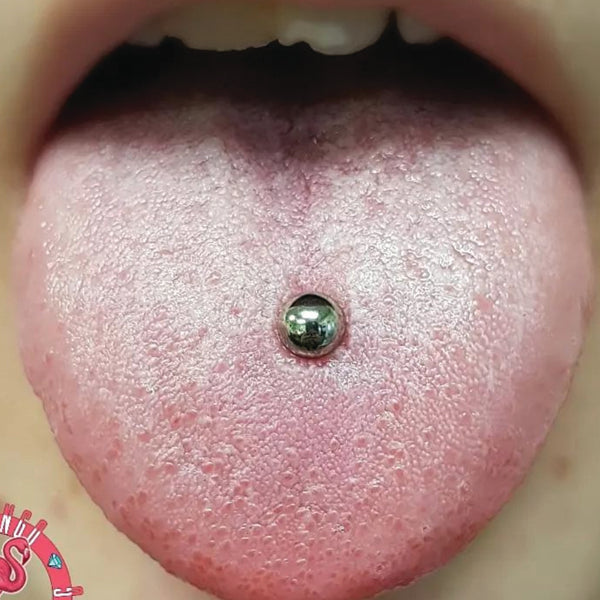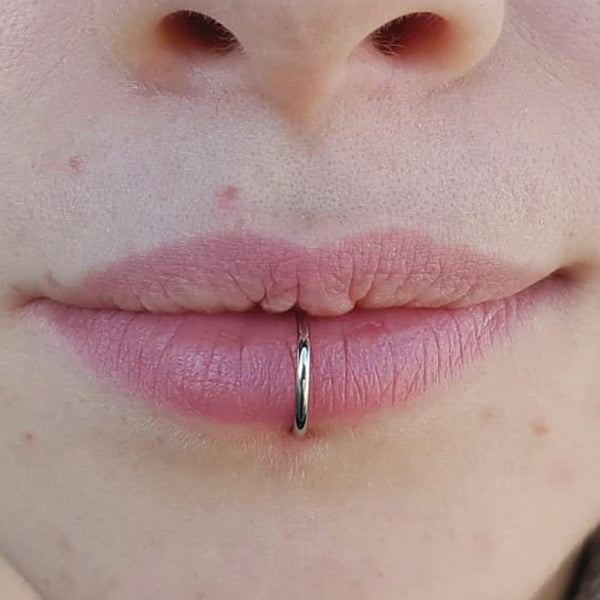Available oral piercings
The following is a list of oral piercings are available at Bombshell Tattoo Galerie in Edmonton to clients aged 14 and over with parental consent, and ages 16 and over with valid government identification.

TONGUE
Tongue piercings are typically done along the center of the tongue, approximately where the webbing (lingual frenulum) attaches the tongue to the bottom of the mouth.
Most clients experience localized swelling, and may find you have a slight lisp and difficulty speaking for the first two to four days, this is temporary and will improve as the swelling decreases.
Healing time is typically around 6 to 10 weeks.

LIP
Lip piercings are any piercing which pass through the lip or lip area. This means that there are several different locations where the piercing can be placed: from the center of the lip to the outside corners.
Clients getting a lip piercing will almost definitely experience localized swelling.
Healing time for your new lip piercing is typically around 6 to 10 weeks.
FAQ about oral piercings
Will my new oral piercing affect eating?
Because of swelling, eating may be uncomfortable for the first couple of days.
During this time, try not to eat anything that further irritates the area, such as solid, tough, crunchy, or hot (spicy or in temperature) foods.
It is best to stick with foods that are softer and do not involve much chewing. Chilled smoothies are always a good idea, especially in the case of tongue piercings.
Can I use Listerine or something similar?
Listerine is formulated for once a day use; most professional piercers find it far too harsh to use repeatedly during the day on a freshly pierced area as it can upset the natural flora in your mouth. (this applies to any mouthwash with a high alcohol content.)
The overuse of Listerine or any similar mouthwash can lead to oral yeast infections.
If you see a thick, white film developing on your tongue and the back of your throat, quit the Listerine and switch to a sterile, wound wash saline instead.
Why do I have to buy new jewellery after healing?
Due to the anticipated swelling of all oral piercings they are always pierced with jewelry that allows additional length to accommodate the increase in size.
Once all the swelling is gone and you are fully healed (about four to 6 weeks), you should change your jewelry to something that fits more snugly to your tongue, lips or cheeks.
A smaller barbell usually makes it easier to talk, easier to hide, and makes it less likely that you will damage your gums or teeth.
Can my new oral piercing damage my gums or teeth?
Yes, unfortunately all oral piercings have the potential to cause damage to your teeth.
The best way to minimize this risk is to make sure your jewelry fits properly; this means putting in shorter jewelry after the first month.
Damage to teeth enamel and gums typically comes from wearing jewelry that is too long causing the barbells to rub against gums or from the client biting the barbell, playing with the jewelry, etc.
As such it is vital that jewelry be downsized after healing.
How soon can I go back to kissing, or engage in oral sex?
For all oral piercings, you must wait until the piercing has healed before engaging in any activities that expose your wound to another persons bodily fluids.
Even if you are already sharing fluids with your partner or have done so in the past, an open wound like a piercing opens up the possibility to pick up bacteria from them, as their body’s normal bacteria is still foreign to your body.
If you do decide to kiss your partner anyway, rinse your mouth—and have your partner rinse his or her mouth—with an antiseptic mouthwash before and after. At the very least, you’ll be kissing clean, fresh breath—but, more importantly, you could be avoiding an unhappy infection.
While we heavily recommend against doing so for at least 6 to 10 weeks. If you do choose to participate in oral sex, make sure it is fluid-safe by using condoms or dental dams. Even if you do not usually use protection with your partner this is to prevent foreign bacteria entering your wound and potentially causing an infection.
Why should I not get my cheeks pierced?
Cheek piercings can be incredibly problematic for even the most experienced client to heal.
They are especially prone to periodic and unexpected swelling, often developing fluid pockets and excessive drainage of lymph during and even after healing. They are extremely difficult to maintain for the life of the piercing, and due to the depth of the piercing often omit odours that are detectable by others even when cleaned regularly.
While healing is not impossible, it’s often a difficult process that takes on average 8 months to a year.
The scars left behind when cheek piercings are removed tend to be substantial and difficult to camouflage.
If you’re still interested in piercing your cheeks, please contact our piercer below. She can talk to you honestly about this piercing, and make suggestions about whether it’s the right one for you.
What to expect
Body piercings vary in healing times anywhere from 8 weeks to a several months depending on the
piercing site.
Everyone’s body is different so be patient and allow your body the time it needs to heal.
Initially there may be bleeding, or occasionally slight bruising around the piercing site.
Slight to moderate swelling can be expected.
The tissue around the piercing can become tender and slightly
red/pink during the first few weeks of healing.
A clear or light yellow discharge might occur off and
on indefinitely.
This discharge forms a crust which you can rinse off gently with warm water.
Do not touch or pick at your piercing and never rotate the jewelry while your piercing is healing!
What to do
Rinse your piercing twice daily (or as recommended by your piercer) in warm running water to soften and remove any crust that may have formed around your piercing.
Warm water helps keep
the area clean as well as increasing circulation which is beneficial to healing.
After the warm water rinse, follow with Simple Care Spray or a Sterile Wound Wash Saline available at any pharmacy.
Spray directly on the piercing twice daily and leave your piercing
alone. DO NOT make your own salt solution at home as this can impede healing.
We are not responsible for lost jewelry so please check your jewelry daily with freshly washed hands.
Threaded jewelry can loosen and fall off.
Playing with your jewelry not only increases your chances of complications during healing, but it may also result in the loosening of threaded ends and in turn the loss of the piercing site so keep your hands away from your piercing as much as possible.
Ensure anything that comes into contact with your piercing such as clothing, bedding, towels etc. are
clean until your piercing is fully healed.
What not to do
Do not touch your piercing unless you are checking the threading. Do not allow anyone else to
touch your piercing.
Never pick at or rotate your jewelry.
Do not use Q-Tips or cotton swabs or any other materials that may leave fibers behind.
Do not bandage your piercing. Refrain from wearing tight clothing.
Do not use antibacterial soaps, peroxide, rubbing alcohol, Bactine, antibiotic ointments
(Polysporin)or other first aid products unless instructed to by your doctor.
Do not submerge your piercing in any bodies of water including bathtubs, lakes, oceans, hot tubs
swimming pools, saunas etc. until it is fully healed.
Do not remove or change your jewelry for at least 8-12 weeks or as directed by your piercer.
Always check with your piercer as to suitable jewelry options for your particular piercing and
anatomy and always be aware of the quality of the jewelry you are putting in your body.
Do not share jewelry. This puts you at risk for disease and/ or infection transmission.
Do not rely on the advice of friends, family or the internet.
Your piercer knows what works best
for her practices. If your piercer is unavailable, or if you suspect complications or infection please
contact your doctor.

